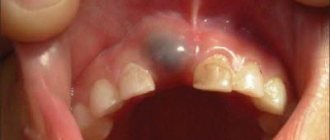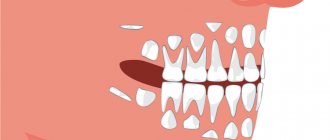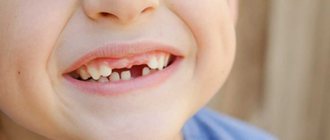Children's teeth appear in a certain sequence and in pairs (for example, two central incisors or two canines). But often the timing of teething in children shifts upward: many parents begin to worry and get nervous, but this is not worth doing, since the deviation from the norm is explained by the individual characteristics of the body, the uncharacteristic course of pregnancy, or various injuries received during childbirth.
Anatomy of permanent teeth
Each molar consists of certain parts:
- crown. This is the part of the tooth that protrudes from the top;
- the root, it goes deep into the alveoli. At the same time, it is attached thanks to special connective tissue bundles. There can be different numbers of roots (1-5 pieces). This moment affects the number of nerves and channels;
- neck. This part is located between the root and the crown.
Tooth tissues are distinguished by their heterogeneity. The enamel is on top and is known for its durability. Once the tooth has erupted, it is covered with a transparent thin layer. This is the cuticle, which eventually changes to the pellicle. The latter is a film that is created from what saliva produces.
Beneath the enamel is dentin, the tissue of the tooth. Dentin is similar to bone when you study how it is built. However, it is more durable because there is a high level of mineralization. In the area where the root is located, the dental tissue is covered with cement. The latter is rich in mineral compounds and is also associated with periodontium. Collagen fibers are used for this.
As for the part of the tooth that is inside, this is the crown and root canal. They are filled with pulp. This is loose connective tissue; it contains nerve endings and blood vessels.
Intramaxillary development
The permanent bite is formed on the basis of dental plates, which are formed inside the pits of stratified squamous epithelium. At approximately the 5th month of the child’s embryonic development, an enamel organ appears along the lower edge of the primordial teeth. As mesenchyme grows into it, dental papillae and sacs are formed.
In total, each child has 20 rudiments in two jaws for the development of replacement permanent teeth, 16 of which are present at the time of birth, and the remaining 4 appear at 1-5 years of life. Being in the same alveolus with the milk sacs, after a while they are separated from them by a bone septum and are placed in separate sockets. The dental plates grow in a posterior direction. The main dental tissues are actively developing - dentin, pulp, enamel, as well as blood vessels and nerve fibers.
Differences between baby teeth and permanent teeth
Permanent and temporary teeth are built in the same way, but still have certain differences between themselves:
- The enamel on baby teeth is whiter. And the enamel on permanent teeth has a yellowish tint;
- the best indicators of density and mineralization are noted behind the molars;
- the pulp of a baby tooth is large in size, and the dense tissues and their walls are thinner;
- permanent teeth are larger in size, here the length is greater than the width;
- The root of baby teeth is short and thin compared to permanent teeth. When the root of temporary teeth is formed, they expand in width. Therefore, the permanent bud has free space to grow.
The completion of tooth root formation occurs at approximately this age:
| Teeth | Upper jaw, age | Lower jaw, age |
| Central incisors | 9-13 | 7-11 |
| Lateral incisors | 9-12 | 8-11 |
| Fangs | 9-12 | 9-12 |
| First premolars | 11-13 | 11-13 |
| Second premolars | 11-13 | 11-13 |
| First molars | 9-12 | 9-12 |
| Second molars | 14-15 | 14-15 |
Since the eruption of third molars does not occur at a specific time, it is impossible to establish a clear age at which their roots are formed.
X-ray results confirm the completion of the process of tooth root formation. The key signs are the absence of an opening at the apex, as well as a pronounced periodontal contour.
Thus, completion of dental growth, including full maturation, usually occurs only between the ages of 15 and 18 years. It is at this time that the maxillofacial apparatus already has the same dimensions as in adults.
Where do teeth come from?
Teeth begin to form and develop when the fetus is still inside the womb (at about 6 weeks). They have their source - the epithelial dental plate. Already by 14 weeks, active formation of dental tissues, which are hard, occurs. Initially, this occurs in the area where the crown will be, and later at the root.
Molars, namely their first rudiments, appear by the 5th month of the embryo. They are located higher than the child’s baby teeth or lower. By the time the child is born, the rudiments are already practically formed in the tissues of the jaw.
Teeth that belong to an additional group (have no predecessors) are formed later. This occurs after about 1 year of life. Why? Because the baby's jaw is still very small and there is not enough space for them.
Teething in children: symptoms
The first signs of the imminent appearance of teeth appear about a week before their appearance. The symptoms will not stop until the tooth breaks through the gum lining.
Signs of teething in a baby are as follows:
- the child becomes irritable for no reason;
- sleep deteriorates (if the child cries at night and tosses and turns, there is no need to immediately start rocking him to sleep - it is better to give the baby the opportunity to calm down on his own);
- the gums become very swollen and swell at the site where the tooth appears;
- the appetite deteriorates, the baby may even refuse to eat altogether, feeling hungry;
- the child begins to chew on various objects to relieve severe itching in the gums;
- salivation increases;
- Due to drooling, a rash may appear around the mouth, chin and chest.
There are also additional ones, i.e. optional symptoms of teething in infants:
- heat. If the temperature has increased, this most likely indicates an inflammatory process that develops in parallel with teething and is in no way connected with it (it could be stomatitis or any cold).
When the temperature rises, you need to carefully examine the oral mucosa. If there are small bubbles filled with a cloudy liquid, erosion, and the gums themselves are bright red, then the child has herpetic stomatitis. Any baby receives antibodies to the herpes virus from its mother, but usually by the time the first teeth appear, their effect ends. Often the catalyzing factor in the development of stomatitis is trauma to the mucous membrane, which is inevitable when teeth appear. If the above signs cannot be detected, then it is recommended to give the baby Panadol (suppositories are the preferred form of medication). As practice shows, it is useless to call a pediatrician, since this is not their specialization. Only a dentist can determine the specific type of stomatitis (aphthous, herpetic, etc.).
- hematomas on the gums. Sometimes the gums become swollen, turning an eerie shade of blue. Despite their frightening appearance, hematomas do not require treatment. Doctor intervention is allowed only for large hematomas that do not decrease over a long time.
- vomit. The only acceptable cause of vomiting is excess saliva entering the stomach and esophagus. If vomiting begins against the background of elevated temperature and, especially, diarrhea, then these symptoms have nothing to do with teething - you need to call a doctor.
- coughing is not a natural cause when teeth appear, unless the child has swallowed saliva that has entered the respiratory tract.
- A runny nose is a sign of a cold, not teething.
What does a dental formula look like?
To make it more convenient to describe teeth and their number, special formulas are usually used. Each tooth has its own number, which is used to decipher its location.
When describing a milk bite, Roman numerals are used:
- incisors – I, II;
- canine – III;
- molars – IV, V.
If we talk about the formula for adult teeth, here the teeth are counted starting from the center:
- incisors – 1.2;
- fang – 3;
- molars (small) – 4.5;
- molars (large) – 6,7,8.
8 is a wisdom tooth; not every person has it.
Caring for children's teeth
The pattern of teething in children determines the approximate time of their appearance, but it is necessary to start observing oral hygiene as early as possible, without waiting for the teeth to erupt.
Breasts cannot take care of themselves, so they need help cleaning their gums. This is done either with the help of a fingertip, or, if there is none, with the help of an ordinary bandage dipped in warm boiled water and wound around the finger.
If teeth begin to erupt, you cannot do without the use of special products (baby pastes, brushes, etc.).
Teething order
Typically, all children start teething at about the same time. Teeth emerge from the molar set at the age of 5, and it is the molars (large ones) that emerge. Then the diagram is as follows:
- Initially, the incisors on the lower jaw change, which are located in the center;
- then the central incisors appear on the upper jaw and the incisors on the sides on the lower jaw;
- at about 8-9 years old, the incisors on the top and sides change;
- up to 12 years of age, molars (small) grow;
- at the age of 13, the fangs change;
- after the child turns 14 years old, the second molars (large ones) come in. They were not included in the milk kit;
- and after another 1 year the third molars (large) appear. This is a wisdom tooth. But he may not appear at all.
Types of teething disorders
Teething in children, the sequence of which is clearly defined, can occur with a delay caused by various reasons (illness of the mother during pregnancy, diseases suffered by the child, etc.). Due to the delay, deformation of the jaws may begin, because There is not enough free space for teeth that have not yet erupted. In this case, only the dentist can decide on treatment after a thorough visual examination of the child and analysis of the photograph taken.
The next very common disorder is enamel hypoplasia, which manifests itself in spots of different colors on newly emerging teeth, pits or grooves. Hypoplasia causes complications during pregnancy.
How to determine that a child will soon have molars?
There are certain signs that indicate that permanent teeth will soon begin to erupt:
- The spaces between the teeth increase. The jaw grows and the free space increases;
- baby teeth become loose as the root gradually dissolves. It cannot be firmly fixed in the jaw tissues;
- in case of loss of a temporary tooth. This confirms that the molar will soon come out as it has pushed out the previous one;
- The gums are slightly swollen and red.
When permanent teeth erupt, the child’s general well-being usually remains the same, the temperature does not rise, and there is no pain.
Teething in children and features of this process
Quite often, a few weeks before the appearance of a baby or molar tooth, a lump filled with a clear or bluish liquid forms on the gum. Naturally, it worries parents, but there is no pathology in this formation, and the lump, which does not look very aesthetically pleasing, does not indicate the beginning of the inflammatory process. In most cases, no intervention by a doctor is required. You can contact the dentist if the lump increases in size: the doctor will make a small incision and release the liquid.
Possible problems
Permanent teeth have just appeared, but this does not mean that there will not immediately be any problems associated with them. Parents should be aware of possible dental problems:
- lack of molars;
- pain in the molar area;
- crooked position of molars;
- molars fall out;
- injuries.
For any of these problems, it is important to contact a specialist in time to receive qualified help.
Formation of periodontium and roots
This stage of development begins after the eruption of permanent teeth and usually lasts for 3.5-5 years. It includes the development processes of surrounding tissues, as well as the root system. At the same time, the crown of permanent teeth at this stage is almost completely formed and is ready for active mineralization after eruption.
The period of development of the root part and periodontal tissues is divided into the following stages:
- active growth of the tooth root in length;
- development and strengthening of the root apex;
- uncovered root tip;
- formation and strengthening of periodontium;
- completion of periodontal and root development.
Adentia and retention
Adentia and retention are specific problems that are possible when changing teeth. Edentia means the complete or partial absence of teeth, which is classified as a pathology and can be solved by installing dentures.
Retention means that the teeth have partially erupted, but remain under the gum. This is a very common occurrence during wisdom teeth eruption. The problem is solved by removing such teeth or by surgery on the gum to make room for complete eruption, if it is not a wisdom tooth.











